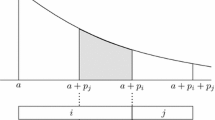Abstract
Consider a set of n advertisements (hereafter called “ads”) A ={A1,...,An} competing to be placed in a planning horizon which is divided into N time intervals called slots. An ad A i is specified by its size s i and frequency w i. The size s i represents the amount of space the ad occupies in a slot. Ad A i is said to be scheduled if exactly w i copies of A i are placed in the slots subject to the restriction that a slot contains at most one copy of an ad. In this paper, we consider two problems. The MINSPACE problem minimizes the maximum fullness among all slots in a feasible schedule where the fullness of a slot is the sum of the sizes of ads assigned to the slot. For the MAXSPACE problem, in addition, we are given a common maximum fullness S for all slots. The total size of the ads placed in a slot cannot exceed S. The objective is to find a feasible schedule \(A' \subseteq A\) of ads such that the total occupied slot space \(\sum {_{A_i \in A'} w_i s_i }\) is maximized. We examine the complexity status of both problems and provide heuristics with performance guarantees.
Similar content being viewed by others
REFERENCES
AdKnowledge System, Engage AdKnowledge Online Advertising Report, http://www.e-biznes.pl/download/oar_3rdqtr00.pdf, 2000.
Adler, M., P. B. Gibbons, and Y. Matias, “Scheduling space-sharing for internet advertising,” J. Sched., 5, 103-119 (2002).
Aggarwal, C. C., J. L. Wolf, and P. S. Yu, “A framework for the optimizing of WWW advertising,” Trends Dist. Syst. Electron. Comm., 00, 1-10 (1998).
Chen, B., C. N. Potts, G. Woeginger, “A review of machine scheduling: Complexity, algorithms and approximability,” in D. Z. Du and P. M. Pardalos (ed.), Handbook of Combinatorial Optimization, vol. 3, Kluwer, Dordrecht, The Netherlands, 1998, pp. 21-169.
Coffman, E. G. Jr, M. R. Garey, D. S. Johnson, “An application of bin-packing to multiprocessor scheduling,” SIAM J. Comput., 7(1), 1-17 (1978).
Coffman, E. G., M. R. Garey, and D. S. Johnson, “Approximation algorithms for bin-packing: A survey,” in D. S. Hochbaum (ed.), Approximation Algorithms for NP-hard Problems, PWS Publishing Company, Boston, pp. 46-93, 1997.
cybereps.com, http://www.cybereps.com/MKcollegeclub.shtml.
Friesen, D. K., “Tighter bounds for multifit processor scheduling algorithm,” SIAM J. Comput., 13, 170-181 (1984).
Friesen, D. K. M. A. Langston, “Evaluation of a multifit-based scheduling algorithm,” J. Algorithms, 7, 35-59 (1986).
Garfinkel, R. S. G. L. Nemhauser, Integer Programming, Wiley and Sons Ltd., New York, 1972.
Garey, M. R., and D. S. Johnson, Computers and Intractability: A Guide to the Theory of NP-Completeness, Freeman, San Francisco, 1979.
Graham, R. L., “Bounds on multiprocessing timing anomalies,” SIAM J. Appl. Math., 17, 416-429 (1969).
Hochbaum, D. S., and D. B. Shmoys, “Using dual approximation algorithms for scheduling problems: Theoretical and practical results,” J. Assoc. Comput. Mach., 34, 144-162 (1987).
Ibarra, O. H., and C. E. Kim, “Fast approximation algorithms for the knapsack and sum of subset problems,” J. Assoc. Comput. Mach., 22, 463-468 (1975).
Interactive Advertising Bureau, http://www.iab.net.
Jupiter Communications, The 1997 Online Kids Report, http://www.jup.com, 1997.
Kalakota, R. and A. B. Whinston, Electronic Commerce: A Manager's Guide, Addison Wesley Longman, Inc., 1997.
Lawler, E. L. and J. M. Moore, “A functional equation and its application to resource allocation and sequencing problems,” Manage. Sci., 16, 77-84 (1969).
Lawler, E. L., J. K. Lenstra, A. H. G. Rinnooy Kan, and D. B. Shmoys, “Sequencing and scheduling: Algorithms and complexity,” in S. C. Graves et al. (eds.), Handbooks in Operations Research and Management Science, vol. 4, 1993, pp. 445-552.
Martello, S. and P. Toth, Knapsack Problems, John Wiley and Sons Ltd., New York, 1989.
Martin, R. K., Large Scale Linear and Integer Optimization., Kluwer, Massachusetts, 1999.
McCandless, M., “Web advertising,” IEEE Intelligent Sys., (1998). May/June p. 8-9
McGuire, T., “Internet: A stream of light,” Intermedia, 29, 19-21 (2001).
Novak, T. P., and D. L. Hoffman, “New metrics for new media: Toward the development of web measurement standards,” World Wide Web J., III(I), Winter, (1997).
Nemhauser, G. L., and L. A. Wolsey, Integer Programming and Combinatorial Optimization, Wiley, New York, 1988.
Pinedo, M., Scheduling Theory, Algorithms, and Systems, Prentice Hall, NJ, 1995.
Rothkopf, M. H., “Scheduling independent tasks on parallel processors,” Manage. Sci., 12, 437-447 (1966).
marketing.htm.
Yager, R. R., “Intelligent agents for world wide web advertising decisions,” Int. J. Intelligent Sys., 12, 379-390 (1997).
Author information
Authors and Affiliations
Rights and permissions
About this article
Cite this article
Dawande, M., Kumar, S. & Sriskandarajah, C. Performance Bounds of Algorithms for Scheduling Advertisements on a Web Page. Journal of Scheduling 6, 373–394 (2003). https://doi.org/10.1023/A:1024060710627
Issue Date:
DOI: https://doi.org/10.1023/A:1024060710627




